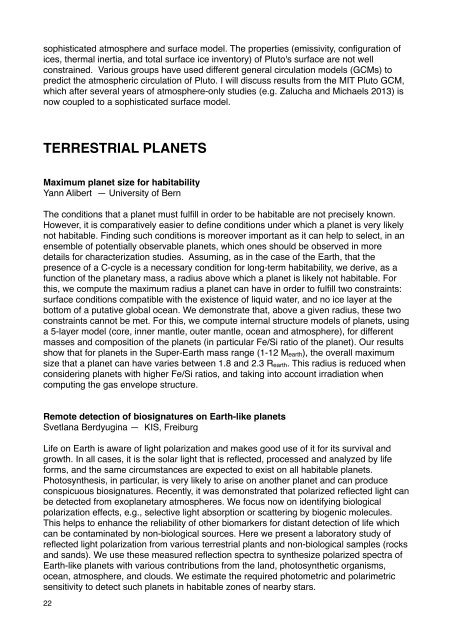Exoclimes_Conference_booklet1
Exoclimes_Conference_booklet1
Exoclimes_Conference_booklet1
You also want an ePaper? Increase the reach of your titles
YUMPU automatically turns print PDFs into web optimized ePapers that Google loves.
sophisticated atmosphere and surface model. The properties (emissivity, configuration of<br />
ices, thermal inertia, and total surface ice inventory) of Pluto's surface are not well<br />
constrained. Various groups have used different general circulation models (GCMs) to<br />
predict the atmospheric circulation of Pluto. I will discuss results from the MIT Pluto GCM,<br />
which after several years of atmosphere-only studies (e.g. Zalucha and Michaels 2013) is<br />
now coupled to a sophisticated surface model.<br />
TERRESTRIAL PLANETS<br />
Maximum planet size for habitability<br />
Yann Alibert! — University of Bern<br />
The conditions that a planet must fulfill in order to be habitable are not precisely known.<br />
However, it is comparatively easier to define conditions under which a planet is very likely<br />
not habitable. Finding such conditions is moreover important as it can help to select, in an<br />
ensemble of potentially observable planets, which ones should be observed in more<br />
details for characterization studies. Assuming, as in the case of the Earth, that the<br />
presence of a C-cycle is a necessary condition for long-term habitability, we derive, as a<br />
function of the planetary mass, a radius above which a planet is likely not habitable. For<br />
this, we compute the maximum radius a planet can have in order to fulfill two constraints:<br />
surface conditions compatible with the existence of liquid water, and no ice layer at the<br />
bottom of a putative global ocean. We demonstrate that, above a given radius, these two<br />
constraints cannot be met. For this, we compute internal structure models of planets, using<br />
a 5-layer model (core, inner mantle, outer mantle, ocean and atmosphere), for different<br />
masses and composition of the planets (in particular Fe/Si ratio of the planet). Our results<br />
show that for planets in the Super-Earth mass range (1-12 Mearth), the overall maximum<br />
size that a planet can have varies between 1.8 and 2.3 Rearth. This radius is reduced when<br />
considering planets with higher Fe/Si ratios, and taking into account irradiation when<br />
computing the gas envelope structure.<br />
Remote detection of biosignatures on Earth-like planets<br />
Svetlana Berdyugina — KIS, Freiburg<br />
Life on Earth is aware of light polarization and makes good use of it for its survival and<br />
growth. In all cases, it is the solar light that is reflected, processed and analyzed by life<br />
forms, and the same circumstances are expected to exist on all habitable planets.<br />
Photosynthesis, in particular, is very likely to arise on another planet and can produce<br />
conspicuous biosignatures. Recently, it was demonstrated that polarized reflected light can<br />
be detected from exoplanetary atmospheres. We focus now on identifying biological<br />
polarization effects, e.g., selective light absorption or scattering by biogenic molecules.<br />
This helps to enhance the reliability of other biomarkers for distant detection of life which<br />
can be contaminated by non-biological sources. Here we present a laboratory study of<br />
reflected light polarization from various terrestrial plants and non-biological samples (rocks<br />
and sands). We use these measured reflection spectra to synthesize polarized spectra of<br />
Earth-like planets with various contributions from the land, photosynthetic organisms,<br />
ocean, atmosphere, and clouds. We estimate the required photometric and polarimetric<br />
sensitivity to detect such planets in habitable zones of nearby stars.<br />
22


